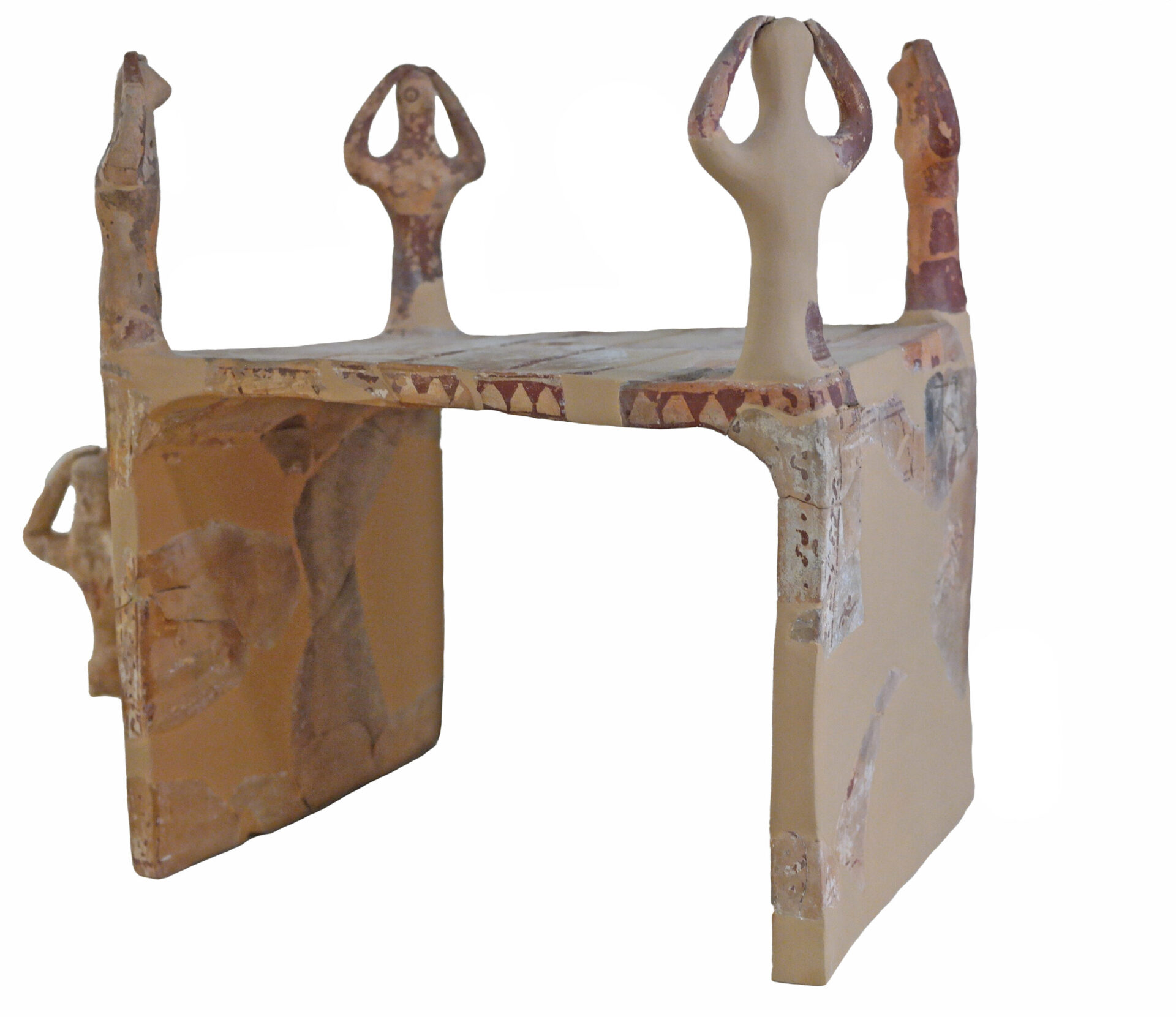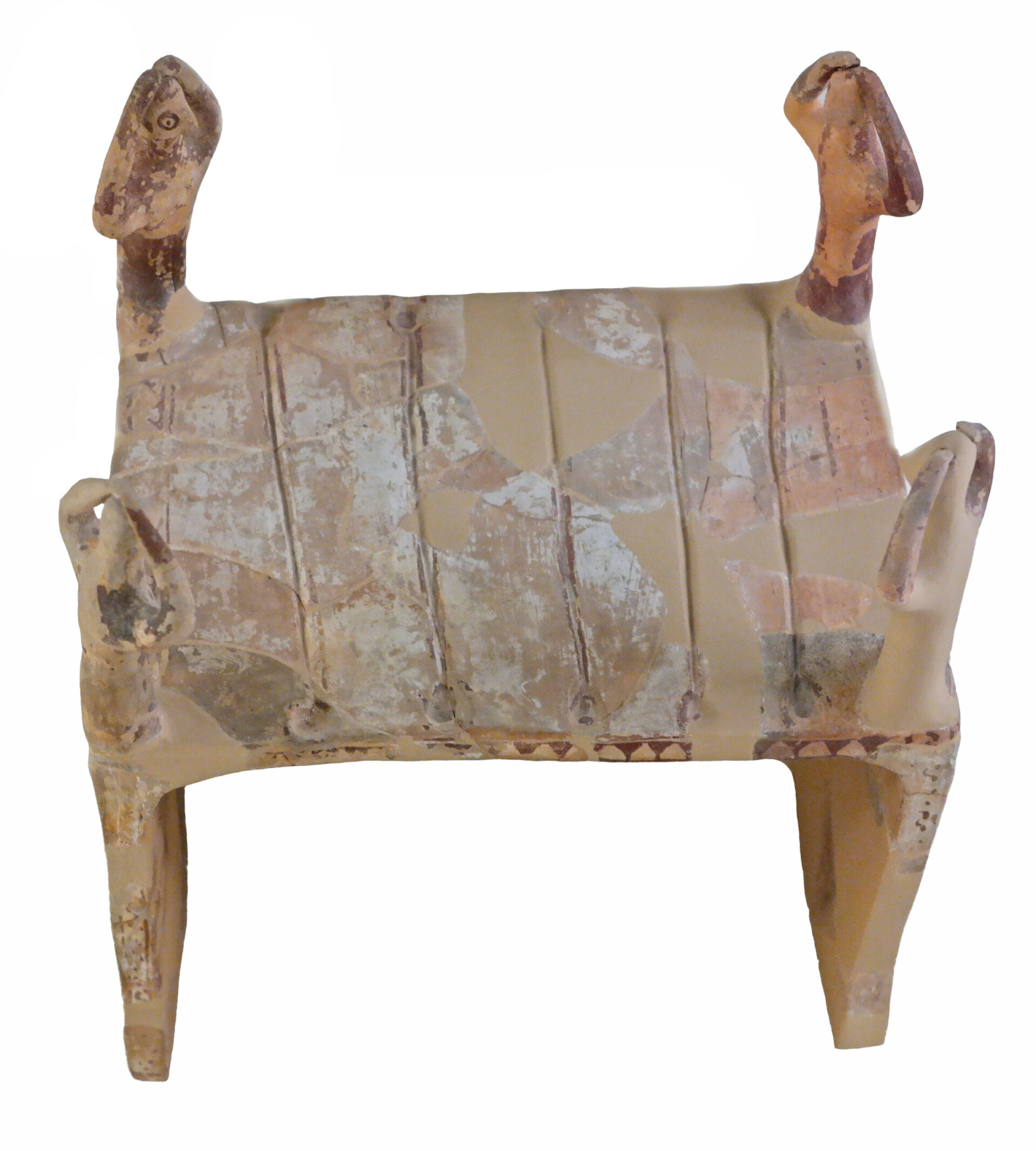Exhibit of the month
Leisure time, play time
Clay game-board model
National Archaeological Museum
Collection of Vases, inv. no. A 25665
Provenance: Vari, Attica
Dimensions: height: 0.18 m., width: 0.183 m., length: 0.248 m., figurine height: 0.10 m.
Date: 675-650 B.C.
Display location: Exhibition of Terracotta Figurines, Room 58, Case 2.
The clay game-board model was found in a cremation burial of the cemetery of the ancient demos of Anagyrous, in the region of modern Vari, Attica. The model is reassembled from pieces and large parts of it have been restored. It bears four terracotta figurines of female mourners, one placed on each of the game-board corners. Five impressed lines are preserved on the game-board surface and oval depressions on either side of each line. The model is decorated with floral ornaments, painted triangles and bands of short zigzag lines. A clay die (NAM A 25664, side length: 0.025 m.) was found together with the model. Numbers in the form of impressed dots are seen on its sides, as well as painted images of a horse, female figures and geometric motifs. Model and die are dated around 675-650 B.C.
The game-board model with five impressed lines on its playing surface refers to the ancient game πέντε γραμμαί – πεσσά πεντάγραμμα – (pente grammai/five lines) attested by the ancient Greek and later sources. The game was played on a five-lined surface with die (κύβος) and five pawns (πεσσούς) for each player. The purpose of the game was to move one’s pawns from the oval depressions at the end of the lines to a safe position or asylum on the middle line or surface center. There are examples of boards of this game made of clay, marble and other materials, as well as enlarged versions with more lines. As a funerary find, the clay game-board model with its mourner figures has been related to ancient ideas regarding the enjoyment of life’s pleasures in the underworld and metaphors regarding life’s journey as a mortal game.
Games played with pawns on a marked board (πεσσεία or πεττεία) and other games of strategy and luck are considered as some of the earliest types of games of many regions, such as Egypt and Greece. According to Greek mythology, pawn games were invented by the Greek hero Palamedes, during the period the Achaeans had to wait in Aulis before sailing to Troy or during the long siege of that city. Among the rather few hypothetical representations of Palamedes in ancient art, we mention the clay die NAM A 19366 (dimensions: 0.042 X 0.04 X 0.045 m.) of around the mid-7th century B.C., with the painted image of a male head on one of its sides.
Dr. Maria Chidiroglou
Bibliography
Dasen V. (επιμ.), 2019. Ludique. Jouer dans l’Antiquité, Catalogue de l’exposition, Lugdunum, musée et théâtres romains, 20 juin-1er décembre 2019, Gent, Lyon.
Καλλιπολίτης Β., 1963. Ἀνασκαφή τάφων Ἀναγυροῦντος, ΑΔ 18 (1963), 115-132.
Kallipolitis-Feytmans D., 1985. Céramique de la petite nécropole de Vari (II), BCH 109 (1985), 31-47.
Murray H.J.R., 1952. A History of Board Games Other than Chess, Oxford.
Παπασπυρίδη-Καρούζου Σ., 1963. Ἀγγεῖα τοῦ Ἀναγυροῦντος, Athens.
Papaspyridi- Karouzou S., 1973. Der Erfinder des Würfels, AM 88 (1973), 55-65.
Pritchett Kendrick W., 1968. Five Lines and IG I2 324, California Studies in Classical Antiquity 1 (1968), 189-198.
Rocco G., 2008. La ceramografia protoattica. Pittori e botteghe (710-630 a.C.), Rahden.
Schädler U., 2009. Pente grammai – the ancient Greek board game Five Lines, στο J.N. Silva (επιμ.), Board Game Studies Colloquium XI, Proceedings, Lisbon, 173-196.
Schädler U. – Chidiroglou M. – Schierup St., Archaic Greek terracotta gaming tables revisited, Pallas 119 (2022), in print.
Whittaker H., 2004. Board Games and Funerary Symbolism in Greek and Roman Contexts, στο Myth and Symbol 2, Symbolic phenomena in ancient Greek culture, Papers from the Second and Third International Symposia on Symbolism at the Norwegian Institute at Athens, September 21-24, 2000 and September 9-22, 2002, Bergen, 279-302.
Xagorari M., 1996. Untersuchungen zu frühgriechische Grabsitten. Figürliche plastische Beigaben als geschlossenen Grabfunden Attikas und Euböas des 10. bis 7. Jhs. v. Chr., Mainz.




